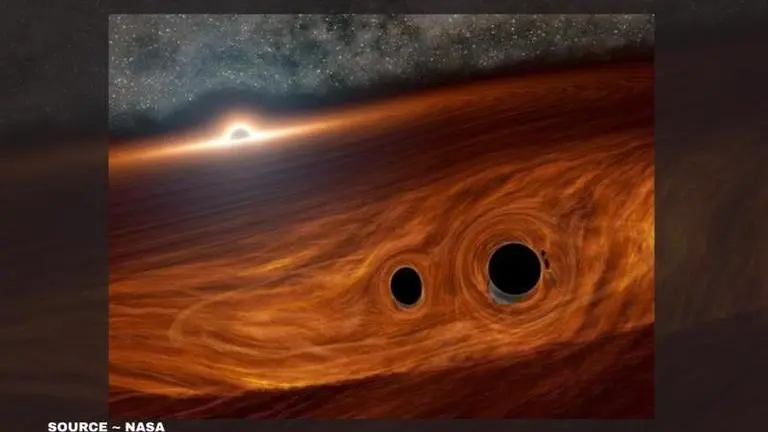Updated 29 June 2020 at 18:47 IST
Astronomers believe they've detected the first known Light Flare from merging Black Holes
Astronomers have eventually found a light flare coming from the merging of two black holes. Read ahead to find more about the event and how they found it.
- Science News
- 4 min read

Withholding infinite mysteries, the Black holes are huge and enigmatic. It is known that there are four types of Black holes: stellar, intermediate, supermassive, and miniature. According to several studies, a Black Hole is formed after the death of huge stars that are 30 times the size of our Sun. Other Stars which are 20 times larger become Neutron Stars and any star smaller or equal to the sun becomes a White Dwarf. However, once Black holes are formed, they are massive and suck everything that comes near them, even other black holes.
Astronomers detect light from the merging of two stars
According to the reports, astronomers detected light from the merger of two black holes. This is a huge development as this is for the first time that the astronomers saw light from a merger. As per scientists, this would provide more opportunities to learn about these mysterious dark objects.
Also Read | Astronomers discover 'Monster' Quasar with humongous Black Hole equivalent to 10,000 suns
It is known to humans that when two black holes spiral around each other and eventually collide, they send out gravitational waves or ripples in space and time. Scientists can detect these ripples with extremely sensitive instruments on Earth. However, black holes and black hole mergers are completely dark, and it is hard to view these events as they are invisible to telescopes and other light-detecting instruments used by astronomers.
Advertisement
However, they have found alternative ideas to observe a black hole merger precisely. The ideas suggest that a black hole merger could produce a light signal by causing nearby material to radiate. This has helped them significantly because the reports revealed that the scientists using Caltech’s Zwicky Transient Facility (ZTF) located at Palomar Observatory near San Diego may have spotted what could be just such a scenario. However, it is not yet confirmed but if it is, by any chance, it would be the first known light flare from a pair of colliding black holes.
Advertisement
When was the Black Holes' merger found?
On May 21, 2019, the merger was identified using two gravitational wave detectors in an event called GW190521g. The two gravitational wave detectors were the National Science Foundation’s Laser Interferometer Gravitational-wave Observatory (LIGO) and the European Virgo detector. This helped the ZTF scientists to look at the right place to locate where the gravitational wave signal originated. These gravitational wave detectors have also spotted mergers between dense cosmic objects called neutron stars, and astronomers have identified light emissions from those collisions.
More about the Black Holes Merger
The ZTF results of the study published in the journal Physical Review Letters revealed that the two partner black holes, each several dozen times more massive than the Sun, were orbiting a third, supermassive black hole that is millions of times the mass of the Sun and surrounded by a disk of gas and other material. However, it is also hypothesized that as the two smaller black holes merged, they formed a new, larger black hole. This would have sent a kick and shot off in a random direction. The study says that this shot may have plowed through the disk of gas, causing it to light up.
The co-author of the new study and an astrophysicist at NASA’s Jet Propulsion Laboratory in Southern California, Daniel Stern stated in the journal that this detection is extremely exciting. He also wrote that "There’s a lot we can learn about these two merging black holes and the environment they were in based on this signal that they sort of inadvertently created. So the detection by ZTF, coupled with what we can learn from the gravitational waves, opens up a new avenue to study both black hole mergers and these disks around supermassive black holes”. Authors of the journal also mentioned that flare detected by ZTF is likely the result of a black hole merger but they cannot completely ignore other possibilities.
In a first, astronomers may have seen light from two smaller black holes that may have merged together to form a new black hole. 🤯 Here’s what we know about this cosmic collision: https://t.co/uQ898J0sBg pic.twitter.com/wlC6cdH1oE
— NASA (@NASA) June 28, 2020
Published By : Yash Tripathi
Published On: 29 June 2020 at 18:47 IST




